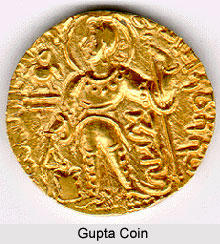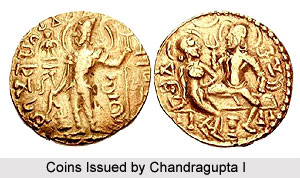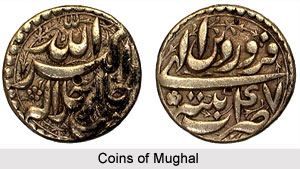 History of Indian coins does provide an unparalleled series of historical documents. Within a span of approximately 2700 years of the historic epoch of India, umpteen realms ascended and fell to dust in various parts of the country. Some of them were gigantic enough to attain the expanse of an `empire`; others were so tiny that they held small territories, engaging an area of only a few square miles. But, all these states, with numerous ruling dynasties and several kings within them, indeed had put forth their own coins. It can thus very well be comprehended that the history of Indian coins and the system of coinage of yesteryears, goes back to indeed undocumented times. These historical Indian coins help to apprehend the socio-political, cultural and administrative aspects of past kingdoms and rulers. They also help immensely in archaeology to determine dates.
History of Indian coins does provide an unparalleled series of historical documents. Within a span of approximately 2700 years of the historic epoch of India, umpteen realms ascended and fell to dust in various parts of the country. Some of them were gigantic enough to attain the expanse of an `empire`; others were so tiny that they held small territories, engaging an area of only a few square miles. But, all these states, with numerous ruling dynasties and several kings within them, indeed had put forth their own coins. It can thus very well be comprehended that the history of Indian coins and the system of coinage of yesteryears, goes back to indeed undocumented times. These historical Indian coins help to apprehend the socio-political, cultural and administrative aspects of past kingdoms and rulers. They also help immensely in archaeology to determine dates.
Influences of Religion in Indian Coins
In the domain of religious history, Indian coins play an equally substantial role. The coins of the Kushanas, who ruled in north-western India during the first and second centuries A.D., support effigies of a number of Greek, Iranian, Buddhist and Brahmanical Gods and Goddesses. The representation of Buddha in human form is noticed for the first time on the coins of Kanishka. On the coins of the Gupta Empire, one can witness the figures of Goddess Durga, Ganga and Goddess Lakshmi.
 Decrypting of Scripts by Indian Coins
Decrypting of Scripts by Indian Coins
The study of ancient Indian coins, also called numismatics, is interesting to pursue. The studies of ancient and medieval coinage have authenticated historical events cognized from literature, artifacts and archaeological findings. In essence, it was the decrypting of Kharosthi script and Brahmi scripts, which allowed historians to read the ancient rock and other inscriptions. In this process thus the whole history of ancient India was unfolded.
Different Dynasties and their Coins
Tracing down the line of the historical evolvement of Indian coins and moving further from the ancient period in Indian coinage, the Early Middle Ages was ushered in by the powerful Gupta Empire and their rulers like Chandragupta I, Skandagupta and Samudragupta. However, the prominence of Hindu rulers had diminished in the historical scale, with the arrival of Muslim invaders and their dynasties from places like Arab, Persia and Turkey. The ultimate ushering in of the Delhi Sultanate(1206-1526 A.D.) had become successful to entirely alter the outline of Indian coins and mintage. Medieval Indian coins point out the economic statuses of those times. Delhi Sultanate sultans, namely Ala ud din Khilji of Khilji Dynasty and Qutb ud din Aibak of Slave Dynasty, had issued an immense variety of gold and silver coins in blowing numbers, due to their treasury being full with the pillage and plunder of southern kingdoms.
 History of Indian coins also helped in discovering the personal traits of individual kings who had indeed issued them. For instance, Muhammad Bin Tughlaq from Tughlaq Dynasty, who has always been considered much ahead of his times, had minted coins in the name of his dead father whom he had slain in repentance during his early years of rule. The coining history of India once more took a dramatic turn under the advent of the Mughal Dynasty in the early 16th century. Beginning from Emperor Zahiruddin Mohammed Babur and perhaps mostly expanding under the reign of Jalaluddin Mohammed Akbar, Mughal mintage took India towards scaling heights, achieving worldwide fame.
History of Indian coins also helped in discovering the personal traits of individual kings who had indeed issued them. For instance, Muhammad Bin Tughlaq from Tughlaq Dynasty, who has always been considered much ahead of his times, had minted coins in the name of his dead father whom he had slain in repentance during his early years of rule. The coining history of India once more took a dramatic turn under the advent of the Mughal Dynasty in the early 16th century. Beginning from Emperor Zahiruddin Mohammed Babur and perhaps mostly expanding under the reign of Jalaluddin Mohammed Akbar, Mughal mintage took India towards scaling heights, achieving worldwide fame.
The pre-colonial India and princely states coinage history become visible soon after the decline of the Mughal Empire, precisely after the death of Aurangzeb. The anarchy that had ensued as a disastrous outcome to the downfall of such a powerful central authority, had prompted for various provincial governing bodies to assert their supremacy, like the states of Oudh and Hyderabad, Gwalior, Rajputana and Mysore.
Indian Coinage during British Rule
History of Indian coins was awaiting its major breakthrough once more under the British Empire with Her Highness Queen Victoria. British casting of coins was the first ever instance of the arrival of modern coins in India. History of Indian coins states in the chronological order that the ones issued after 1840, had held the portrait of Queen Victoria. The first coinage under the crown was issued in 1862. The Indian Coinage Act was passed in 1906, which ordered the establishment of Mints as well as the coins that would be issued and the criteria that would be maintained. However, acute shortage of silver in consequence of World War I, led the British Government to issue paper currency of One Rupee and Two and a half Rupees. This significant move was very much followed as a path breaking lineage towards the historic system of coining under Republic India.
Indian Coinage after Independence
India acquired its Independence on 15th August, 1947. During the period of sufficient and most-wanted transition, India retained the monetary system and the currency and coinage of the earlier colonial period. India brought out its distinguishing coins on 15th August, 1950. Besides the usage of copper, gold and silver coins in history of India, it was for the very first time in the history of Indian coins that `pice` and `anna` systems were introduced in metals like nickel and bronze, aluminium and eventually, the arrival of stainless steel. The introduction of paper currency was perhaps the most sublime breakthrough after British Raj, which had remained witness of the bringing in of bank notes printed from Mint and issued by the Reserve Bank of India under strict legal rules.



















